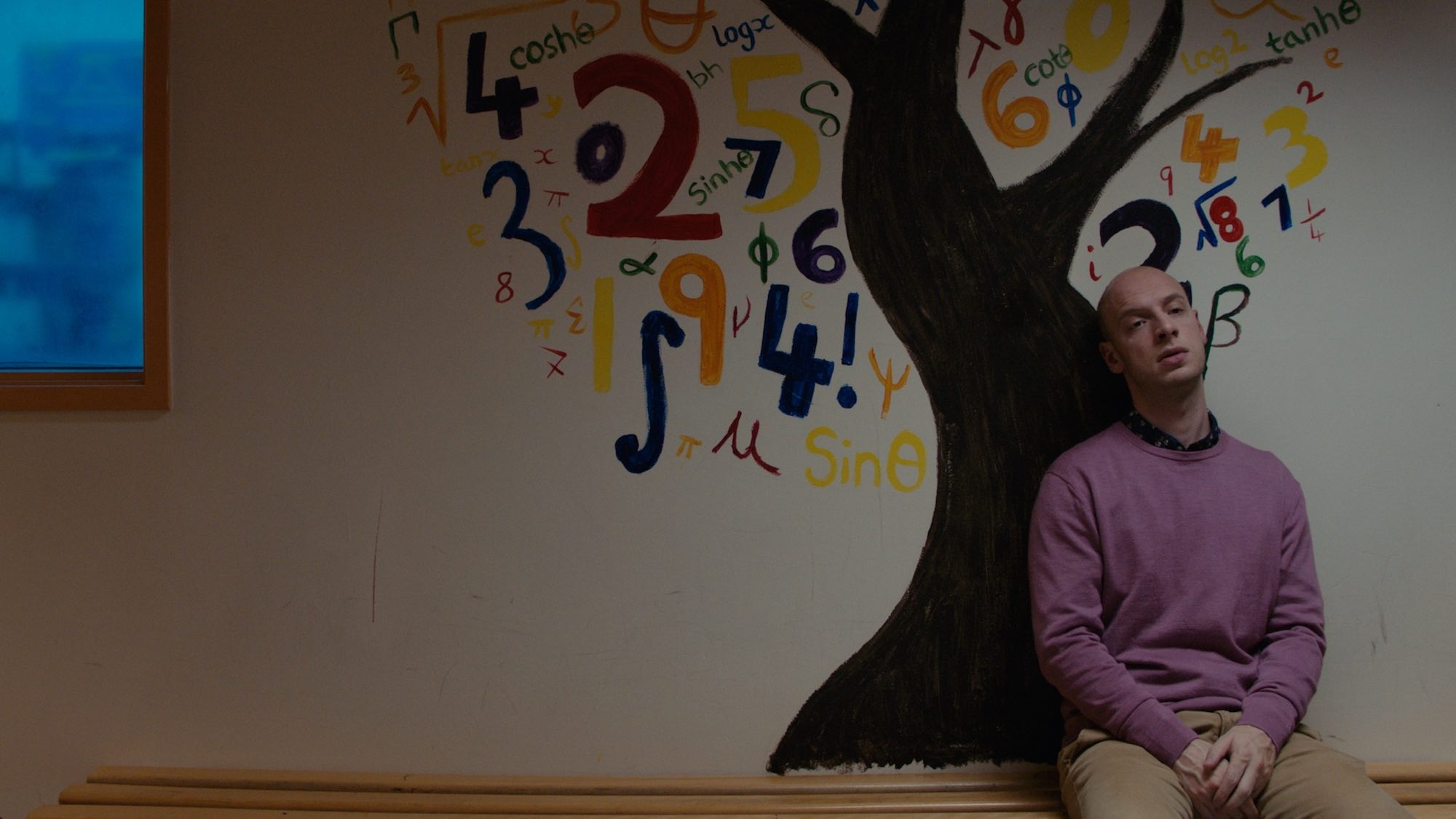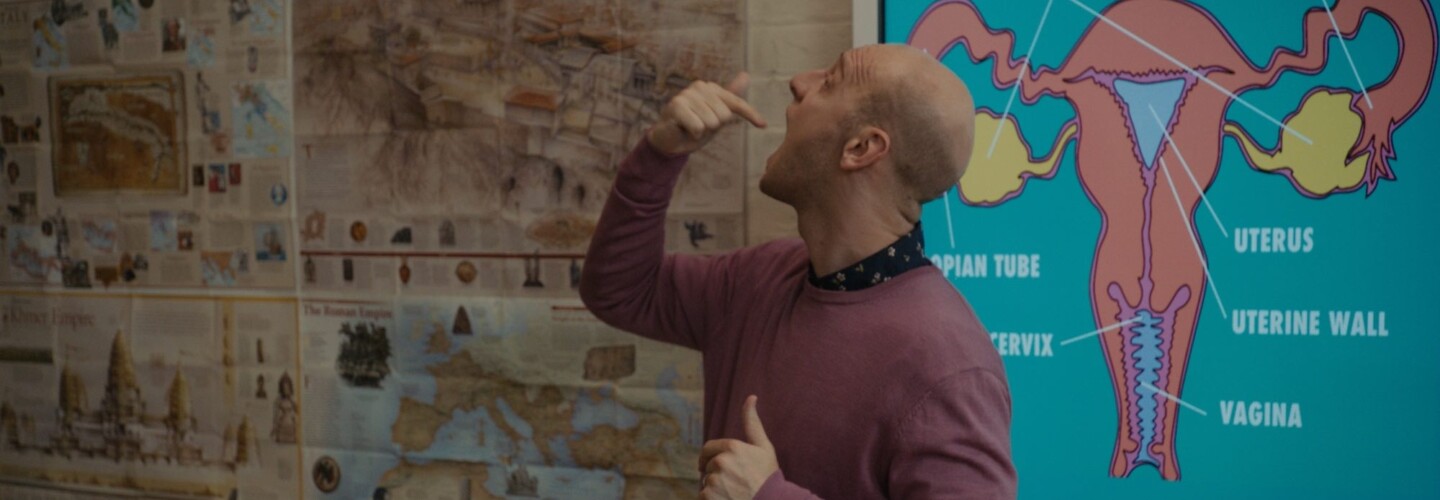
Alice Seabright returns to DN following her wonderful first short Pregnant Pause, with comedy short Sex Ed, about a Sex Education teacher appropriately named, Ed. We meet Ed during an intense moment of contemplation as he prepares for a day of teaching, he’s clearly dealing with some heavy news and through Alice’s clever and succinct direction, we become absorbed in the stress and trauma he’s dealing with as he enters the classroom. Ahead of Sex Ed’s screening at The Shortest Nights, we asked Alice to share how she used direction to reflect Ed’s emotions, how working with Mark Weinman (who portrays Ed) influenced the screenplay and how working with a classroom of teenagers challenges a production.
Where did the idea for Sex Ed begin? How did it evolve?
I co-wrote the script with Mark Weinman, who plays Ed. Mark has been a teaching assistant in schools and sat in on a few Sex Education classes. We ended up talking about that and immediately saw a character and an interesting situation there. We loved the idea of someone whose job was to talk about sex and intimacy with people at an age where they are so embarrassed, so afraid of showing any vulnerability and yet so completely out of their depth. Particularly in an era of easily accessible online porn, these kids know so much and yet so little. And it was a great opportunity to write lots of jokes about penises.
Ultimately what we were interested in was throwing our character into that pressure-cooker situation and watching him break. So the idea of his personal problem getting in the way of his lesson emerged. Every beat of the lesson, every rude personal question, is chipping away at his ability to keep it together. I remember moments at school when you would see your teacher’s facade break and you would go from seeing them as an annoying figure of authority to a vulnerable human being like yourself. That’s what we wanted to capture.
It was a great opportunity to write lots of jokes about penises.
We also ended up finding ourselves talking about expectations around gender, and particularly masculinity. All the boys in the class are desperately putting on a front and so is poor Ed, until he can’t do it anymore.
You drew such a beautiful performance from Mark, it’s he that carries the film through to its eruptive finale, how was it working with him to create Ed?
Mark is simply an incredible, incredible talent. I saw him a few years ago in a one-man show called Captain Amazing, written by a great playwright called Alistair McDowall, and had wanted to work with him ever since. So when we found this idea, it was a process of absolute joyful collaboration. As we wrote it together, our conversations about the character and each line in the script were incredibly in depth, trying to understand exactly where Ed was coming from at each point. We also had a lot of fun mucking about and coming up with silly moments, quirks of character, and funny lines.
Mark was also incredibly dedicated to the work. We were planning to do a nine minute unbroken shot which is a huge challenge – most of all for the camera operator and the performer. So we rehearsed a lot, as well as improvising a lot, both with and without the young actors. In fact, during the casting process, Mark improvised as Ed for every session opposite the actors we were seeing. I did wonder if he would lose his sanity in the process, but it was an invaluable way for him to really develop a deep connection with the character he was playing. I think it really shows in the final film – both in his commitment to the part, but also in how empathetically he plays him. Ed is a comedic character to start off with – we laugh at his silly expressions and his try-hard attitude. But by the end, hopefully we connect with him, and that is down to the fact that Mark never played him judgementally, always from a place of truth.

From a filmmaking standpoint, I thought the direction was exceptional, everything boils up in the background right into Sex Ed’s final moments. Could you talk a bit about your directorial choices, the use of one take in the classroom? When you thought it was necessary to move the camera closer to Ed? And working with the younger actors in general?
The decision to shoot the whole classroom scene in one shot came quite early, basically at conception. I always thought of going into the classroom as almost like diving underwater for Ed, holding his breath until the class is finished. He’s not literally holding his breath, but he’s holding in his emotions, so holding the take was kind of like replicating that for the audience. By not cutting, we’re holding the audience in the situation, sort of not allowing them to blink or breathe until we’re done.
The other idea that came very early on, that was tied to the long take, was withholding the students from view for long periods of time. I always feel that some things are more funny when you imagine them than when you see them, that the reaction is more interesting than the action. So that’s what we were going for – often keeping the kids out of sight so your imagination can run wild as to what they’re up to. There’s a great Joyce Grenfell sketch set in a classroom in which she occasionally says “George, don’t do that!”. The more we hear it, the funnier it gets, precisely because we never find out what George is doing.
With Steven Ferguson, the Cinematographer, who is brilliant, we discussed in huge detail how each of the shots was going to engage us with Ed’s inner state, from the starting close-up that zooms out, to the ways in which the long take could develop. There were certain beats that we wanted to mark, for example when Ed’s facade is dented, or conversely moments when we wanted to see his point of view on the classroom.
We also wanted to replicate the chaos he was experiencing during the moments when the class lose control, and we did that with fast camera movement. Steven also had the genius idea to hide a zoom while the camera was moving around in the chaos section – we zoomed out as the Steadicam operator moved in, so getting that close-up distorted wide-angle feel at this crucial moment for the character.
The advantage of running a shot for so long is that you’re really creating the situation in the room rather than reconstructing it later in the editing suite.
The other person to mention is our Steadicam Operator, Svetlana Miko, who was of course a huge part of achieving the effect. We choreographed the whole thing according to the discussions Steven and I had had in advance, and she was part of that process including offering suggestions based on story and character. She understood how the camera was tracking Ed’s state of mind really well, so she was able to react to the rhythm of the scene and respond to the beats rather than simply follow the choreography. Each attempt at the shot was of course ever so slightly different, and it was her understanding of the meaning behind the choreography that enabled her to pull it off.
The young actors blew me away. We had cast them from an audition process which was all improvised, so I knew we were working with performers who could really respond in the moment truthfully and naturalistically. We spent a day rehearsing with the five main students, as the scene relied on their timing and cues to work. But around the lines they had to hit, there was a certain freedom – of reaction, laughter, actions, which was what was so exciting to watch.
The amazing thing was that when on the day they were joined by all the other students, the energy really shifted. The scene suddenly felt real. Also, Mark didn’t really go full tilt on his performance in any of the rehearsals, so when the students were faced with his breakdown for the first time, again it really felt quite electric. That’s the advantage of running a shot for so long is that you’re really creating the situation in the room rather than reconstructing it later in the editing suite.





Have you shown Sex Ed to any teachers yet? What do they think of it?
A filmmaker friend of mine was a teacher for ten years and he gave me notes on the script. I was worried about showing the final film to him, as I knew he would see right through if it seemed fake, but his reaction was really lovely. Mostly people seem to be brought back to their own experiences as students – and often tell me it makes them remember how awful they were to their teachers.
Are you working on anymore films at the moment?
I’ve just finished a new short film called Strange Days, a coming of age story, which I’m really looking forward to sharing. I’m about to start prepping another quite ambitious short, which is a road trip film set on a narrowboat. It’s about two women in their early 60s who were best friends when they were teenagers, who are reunited when one of them wants to sell the narrowboat she grew up on. We’re filming on the River Lea, which is such an incredible and strange landscape – where graffitied bridges and marshes, wild geese, pylons and power stations all sit next to each other. We’re shooting in July.
I’m also developing several features and TV projects, some with the wonderful Anna Hargreaves, Producer of Sex Ed, and others with production companies and broadcasters.
For more, be sure to check out DN’s full coverage of The Shortest Nights 2018


